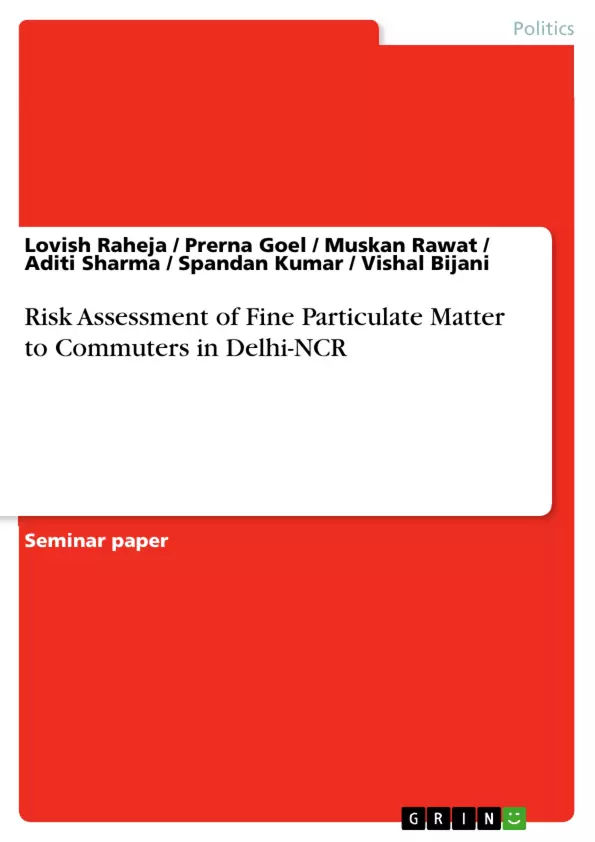The present study makes an attempt to understand the non-carcionegenic and carcinogenic risks due to the exposure of NCR commuters to the high PM2.5 levels and a comparative analysis of exposure within three kinds of groups- male and female, students, official staff and non-official staff, and normal and overweight/obese.
India has been facing high ambient air pollution levels for many years now. Particulate pollution has been one of the major concerns in this regard as almost all the population of the country is exposed to unhealthy fine particulate matter (PM 2.5) concentration and is considered one of the severely impacted countries in the world due to the same. Some of the worst levels of pollution in this category in the country have been witnessed in the areas of the National Capital Territory and adjoining regions. A large proportion of the exposure to these PM2.5 levels is possibly experienced during daily commutating trips. Hence, it becomes essential to analyze the present status of commuter’s exposure to PM2.5 in the NCR region.
The literature review indicates the need for understanding the risk status of commuters in the concerned region in a recent context and in a more generalizable and cumulative way. Furthermore, these risk assessment studies are usually ending by giving cumulative outputs and interpretations for the total population. However, it is important to note there may be intra-population heterogeneity in this context, which also is needed to be accounted for. For example, outdoor workers, those in informal sector or those engaged in non-official work may be more exposed or at a relatively higer risk to the pollution levels specifically those whose work is more oriented towards commuting such as auto-rickshaw drivers, street vendors, users of cart-vehicles, door-to-door service people etc. Hence, there is a need of solid evidences and study of population in those lines i.e., risk to the official and non-official workers. There are also evidences of difference in exposure to males and females in various studies. Similarly, there are differences observed in the exposure and effects of particulate pollution to normal and obese individuals.
Inhaltsverzeichnis (Table of Contents)
- INTRODUCTION
- METHODOLOGY
- Questionnaire Rationale and Design
- Estimation of Exposure Concentration through Commuting
- Estimation of Exposure Rates and Inhaled Doses through Commuting
- Estimation of Hazard Quotient
- Estimation of Lifetime Lung Cancer Risk
- Data Analysis
Zielsetzung und Themenschwerpunkte (Objectives and Key Themes)
This study aims to understand the non-carcinogenic and carcinogenic risks associated with exposure to fine particulate matter (PM2.5) among commuters in the Delhi-NCR region. It specifically focuses on evaluating the exposure of different population groups, including males vs. females, normal vs. overweight/obese individuals, and official vs. non-official staff.
- Assessment of PM2.5 exposure among commuters in Delhi-NCR
- Comparison of exposure levels across different population groups
- Evaluation of non-carcinogenic risks using hazard quotient
- Estimation of lifetime lung cancer risk from PM2.5 exposure
- Analysis of intra-population heterogeneity in exposure and risk
Zusammenfassung der Kapitel (Chapter Summaries)
- INTRODUCTION: This chapter provides an overview of the air pollution situation in India, emphasizing the high levels of PM2.5 concentration, particularly in Delhi-NCR. It highlights the importance of understanding the exposure risks faced by commuters in the region and the need for a comprehensive risk assessment study considering different population groups.
- METHODOLOGY: This chapter outlines the methodology used in the study, including the design of a questionnaire to assess commuting time spent in different micro-environments, the estimation of exposure concentration through commuting using available ratios of in-microenvironment and ambient concentration, and the calculation of exposure rates, inhaled doses, hazard quotient, and lifetime lung cancer risk.
- Questionnaire Rationale and Design: This section describes the development of a questionnaire designed to collect data on commuting time spent in various micro-environments, considering weekday and weekend commuting patterns and individual characteristics.
- Estimation of Exposure Concentration through Commuting: This section explains the method used to estimate exposure concentration by utilizing previously established ratios of in-microenvironment and ambient PM2.5 concentration, along with mean ambient concentration data.
- Estimation of Exposure Rates and Inhaled Doses through Commuting: This section focuses on calculating exposure rates and inhaled doses of PM2.5 by incorporating minute ventilation rates specific to different commuting modes and micro-environments.
- Estimation of Hazard Quotient: This section defines the hazard quotient as a ratio of the average daily dose to the reference dose and provides the formula used to calculate it. The study uses previously established values for reference dose and inhalation rates.
- Estimation of Lifetime Lung Cancer Risk: This section explains the estimation of lifetime lung cancer risk from PM2.5 exposure using the unit risk value for PM2.5 and a previously established formula.
- Data Analysis: This section outlines the data analysis methods employed in the study, including descriptive statistics and a comparative analysis of exposure levels, hazard quotient, and lung cancer risk across different population groups.
Schlüsselwörter (Keywords)
The study centers around the key concepts of fine particulate matter (PM2.5) exposure, commuters' risk assessment, non-carcinogenic and carcinogenic risks, hazard quotient, lifetime lung cancer risk, intra-population heterogeneity, commuting micro-environments, and exposure scenarios. The study utilizes existing data on ambient PM2.5 levels and established formulas to evaluate the risk associated with commuting in the Delhi-NCR region.
- Quote paper
- Lovish Raheja (Author), Prerna Goel (Author), Muskan Rawat (Author), Aditi Sharma (Author), Spandan Kumar (Author), Vishal Bijani (Author), 2022, Risk Assessment of Fine Particulate Matter to Commuters in Delhi-NCR, Munich, GRIN Verlag, https://www.grin.com/document/1337259



